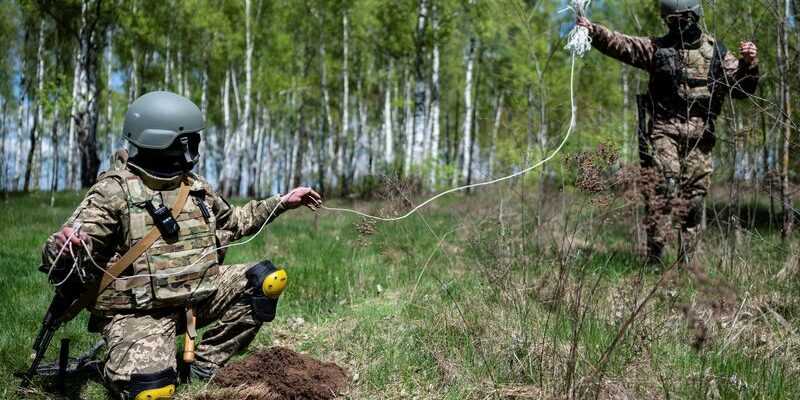After failing to take the capital kyiv in the first weeks of a war that killed thousands and leveled cities, Russia has stepped up its attacks on eastern and southern Ukraine, where the port of Mariupol, on the Sea of Azov, is among its main targets.
Russia declared victory over Mariupol on April 21 after weeks of siege and bombardment. The city is key to Moscow’s efforts to cut Ukraine off from the Black Sea – vital for grain and metal exports – and connect territory controlled by Russia.
The United Nations and the Red Cross evacuated hundreds of people from Mariupol and other areas this week. But some 200 civilians, as well as Ukrainian fighters, are still holed up in a network of underground bunkers in Mariupol’s Azovstal steelworks, according to Ukrainian officials.
Russia has promised to suspend Azovstal military activities for Thursday and the following two days to allow civilians to leave. In an early morning speech, Zelenskiy said Ukraine was ready to secure a Mariupol ceasefire.
“It will take time just to get people out of these basements, these underground shelters. Under current conditions, we cannot use heavy equipment to clear the rubble. Everything has to be done by hand,” said Zelenskiy.
Ukrainian fighters inside Azovstal are waging “difficult and bloody battles” against Russian troops, Denis Prokopenko, a commander of the Ukrainian Azov regiment, said late Wednesday. A Ukrainian parliamentarian said Russian forces were inside the factory.
More than 300 civilians were evacuated on Wednesday from Mariupol and other areas of southern Ukraine as part of a joint UN-Red Cross operation, said Osnat Lubrani, humanitarian coordinator for the UN for Ukraine.
“While this second evacuation of civilians from the Mariupol areas and beyond is significant, much more needs to be done to ensure that all civilians caught up in the fighting can leave, in any direction they wish,” Lubrani said. .
It was unclear if further UN evacuations were planned. Tetyana Trotsak, a Ukrainian evacuee who was among dozens of people who reached a Ukrainian-held town this week, expressed her fears for those still trapped inside the steelworks.
“God forbid we see more shells hit near the bunkers where the civilians are,” Trotsak said.
BATTLES IN THE BORDER AREAS, DONBAS, KHARKIV
Russia launched its invasion on February 24, describing it as a “special military operation” to disarm Ukraine and defend its Russian-speaking population against fascists.
kyiv and its Western supporters say it is a pretext for President Vladimir Putin’s unprovoked war of aggression that has driven more than 5 million Ukrainians to flee abroad.
Russian forces have carried out sporadic attacks on kyiv and parts of western Ukraine since withdrawing from areas around the capital in early April. Russian forces fired nearly 100 shells at border areas north and east of kyiv, Ukrainian border guards said late Wednesday.
But Moscow has turned its attention to capturing Ukraine’s eastern region, Donbas, made up of two provinces – Luhansk and Donetsk – which are under the partial control of Russian-backed separatists.
Russia’s defense ministry said late Wednesday that its air force had destroyed six Ukrainian Luhansk drones. Russian missiles destroyed an American-made counter-battery radar station in the town of Popasna, also Luhansk, he added.
Ukraine’s military said Thursday that its forces repelled 11 Russian attacks, shot down four Russian planes and destroyed more than a dozen Russian military vehicles, including tanks.
Fighting also raged northeast of Kharkiv, Ukraine’s second-largest city, where Russian shelling killed a resident and injured an 11-year-old boy, the Kharkiv regional administration said.
Residents should not leave bomb shelters unless absolutely necessary, the regional administration added.
Reuters could not immediately verify reports of developments on the battlefield.
BAN ON PETROLEUM?
The United States and its European allies imposed sweeping sanctions on Moscow following the invasion and provided Ukraine with billions of dollars in aid, including weapons which kyiv said resulted in heavy Russian casualties.
Adding pressure to Russia’s already battered economy by $1.8 trillion, the European Union on Wednesday proposed phasing out imports of Russian crude oil within six months and refined products by the end of the year. anna.
“Putin must pay a price, a high price, for his brutal aggression,” Ursula von der Leyen, head of the European Commission, told European lawmakers applauding Strasbourg.
The plan, if approved by the 27 EU governments, would follow US and UK oil bans and be a turning point for the world’s largest trading bloc, which remains dependent on Russian energy and must find supplies alternatives.
A source said EU envoys could reach an agreement on Thursday or later this week on the plan, which also targets Russia’s main bank, its broadcasters and hundreds of people.
The Kremlin said Russia was weighing various responses to the EU plan, adding that the measures would be costly for European citizens.
